
Back to Loco of the Month homepage
Back to Sidestreet Bannerworks
.
October 2005
Gordon Bennet 0-4-0T
by Marc Horovitz

This locomotive resembles, superficially, at least, an 0-4-2T tram engine built by Kitson for the Castlederg and Victoria Bridge Tramway, an extremely obscure line in Ireland. Only a couple of small books have been written on this line, neither of which I posses.
What makes this a "tram" engine is principally the side skirts that cover the drive wheels. Tram locomotives like this were most often associated with railways that ran in or next to a roadway. The side skirts covered all of the motion, which was widely thought to be a source of terror to horses.
The model
This locomotive came to me through a friend, who acquired it at an auction. Because of this, any provenance that it might have had was lost. What is known is that it is a cosmetically modified Archangel product, probably a Sammy or Brick. Archangel often stamps the date of manufacture somewhere underneath. However, this does not appear to have been the case here.
Who owned and modified this engine is not known to me. (If someone who reads this knows, I'd be glad to hear from you.) The locomotive appears to be mostly stock, including its solid side tanks. However, the cab is new, as are the skirts.
In addition to modifying the cab, the unknown builder added an interesting fuel-supply system. There is a brass tube that goes up the outside of the engine's back plate to the roof. Toward the lower end it enters the cab through a hole. Inside the cab a silicon tube has been attached to it, which communicates with the filler tube on the tank.
Additionally, the rear buffer beam has been unobtrusively drilled to accommodate a second, short length of silicon connected to the fuel tank's overflow pipe. Thus, filling the tank is convenient and easy, with the meths being pumped in the top via a syringe until it comes out the overflow.
A double-armed regulator lever has been fitted so that the engine can be controlled from either side by reaching into the cab. Aside from that, Archangel's usual minimal fittings have been applied: a safety valve and a blowdown in the cab.
The dome (which was turned from the solid) also appears to have been modified to accommodate a dummy whistle on one side and sand line on the other. A notch has been carved out of the left-hand side of the dome with a file, and the whistle screwed in. The dome and its appurtenances are easily removed so the boiler can be filled through the safety-valve hole.
Gordon Bennet is powered by a single, fixed, D-valve cylinder between the frames. Reversing is through a slip eccentric.
And the name? Another mystery. When the name Gordon Bennet comes up, the person usually referred to is James Gordon Bennet, who was born in New York in 1849. He became a colorful adventurer who was capable of surprising things (like flying an airplane through an open barn). His name somehow became an expletive or expression of surprise, as in, "Gordon Bennet! Did you see that?!" The reason this locomotive was named Gordon Bennet is lost in the mists of time. Perhaps it was a different Gordon Bennet altogether.
The run
I ran this engine once or twice in England, where I purchased it. It was able to manage a single, large Archangel coach up a fairly steep incline in cool weather. For today's test (which was on level track in warm weather) I loaded it up with two coaches and four, small, four-wheel wagons.
After preparing the engine and lighting it off in the usual way, I sat back and waited for pressure to rise. The engine has no pressure gauge, so I relied on the safety valve to let me know that steam was up. I opened the throttle and moved the engine back and forth a little to clear the cylinder. It showed signs of life immediately. I coupled up its train and turned it loose on the mainline.
Gordon Bennet handled the train without complaint, making lap after lap at a prototypical speed. The safety valve has Archangel's usual flatulent charm, and it rudely let go at varying intervals. I stopped the train a few times to top up the fuel, but aside from that it ran happily for half an hour or so.
Sophisticated locomotives, with their complicated valve gear, internally fired boilers, and plethora of appliances are all well and good. But when it comes to plain, sweet running, little can top a pot-boilered locomotive with a single cylinder.
.
|
|
|
| Builder | Archangel Models (Great Britain) |
| Date built | 1980s (estimated) |
| Gauge | 0 (32mm) |
| Scale | 16mm |
| Boiler | Pot |
| Fittings | Safety valve, throttle, blowdown |
| Fuel | Alcohol |
| Blow-off pressure | 50 psi (estimated) |
| Cylinders | One, double acting, piston-valve, between the frames |
| Reversing gear | Slip eccentric |
| Lubricator | Displacement |
| Weight | 6 lbs. 3 oz. |
| Dimensions | Length over end beams, 9"; width, 3-7/8"; height, 6-1/4" |
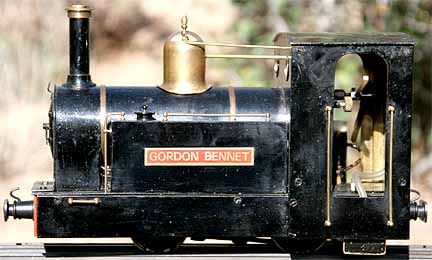
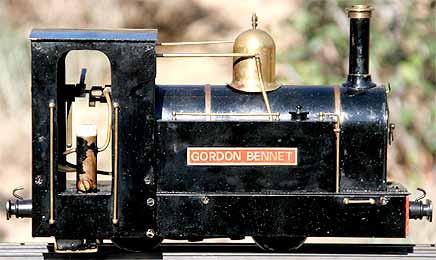
.
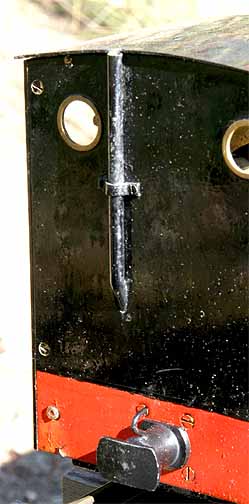
Right: Inside the cab, the pipe is connected to a silicon line, which goes into the fuel tank beneath the footplate.
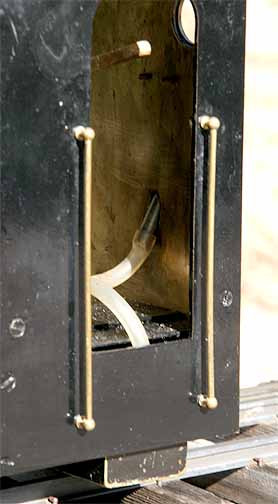
Below: Underneath, the engine resembles any Archangel product of its type and vintage. A single cylinder is housed between the frames and is controlled by a slip eccentric on the rear axle. A two-wick burner heats the boiler, fueled by a large tank at the rear.

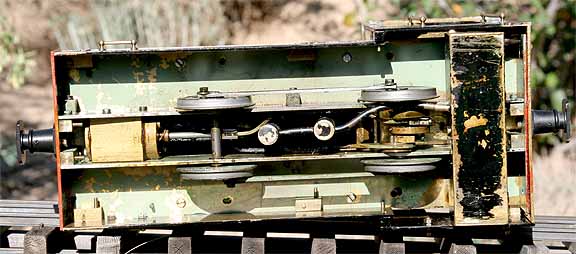
Back to Loco of the Month home page
Back to Sidestreet Bannerworks home page
This page and its contents
Copyright Sidestreet Bannerworks, 2005
.